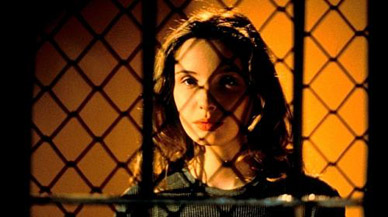Chapter Two - Three Colors: White
By Brett Beach
November 24, 2009
With impromptu or unofficial movie series, those that may only be appreciated or observed with the passage of time (or if a director says, "Hey, these films are connected!"), it becomes more a matter of considering the Chapter Two in and of itself and not worrying about comparing it favorably or otherwise to the first film or later films. Some of these that may occur in future columns then could be: Antoine et Collette (the second installment in Truffaut's "Adventures of Antoine Doinel" series_); William Shakespeare's Romeo and Juliet (the second film in Baz Luhrmann's "Red Curtain" trilogy); Flirting, (John Duigan's follow-up to his coming-of-age tale The Year My Voice Broke); Barcelona (Whit Stillman's second foray into young 1980s upper-crusters on the social make); For A Few Dollars More (Leone's second film in his "Dollars" trilogy); Brazil (part two of Terry Gilliam's self-proclaimed "Imagination" trilogy), and so on. Perhaps I may even have to create my own observed series if there is ever a film I want to review but couldn't do otherwise? No, no that would fall strictly under the BOP Abuse of Power Act of 2005. Oh, well...
To come back to the film at hand, White is certainly the trickiest of the Three Colors trilogy to review, because it is seemingly the least forward, certainly nothing at all like what the DVD front photo of a smiling, half-naked, vaguely alien-looking Julie Delpy might suggest. Blue is marked by Juliette Binoche's effectively muted lead performance and a devastating car accident that sets the plot in motion. Red is a rapturous tale of paths not taken and choices undone, redemption and almost-love and secured Best Director and Best Original Screenplay nominations for its auteur. The closing minutes of Red bring the series full circle and although you don't have to see all three to feel at least some measure of Kieslowski's emotional gambit, it means more if you have. Red was also the most commercially successful, making more itself than the combined domestic grosses of Blue and White.
And White? White is, well, it is certainly the most "inconspicuous" of the bunch, mirroring one character's apt description of the protagonist Karol Karol (wide-eyed sad sack/everyman Zbigniew Zamachowski). If white as a color seems to be marked by an absence or a lack of (as Richard Dyer argued in his ridiculously engaging book on the subject and history of white-ness) then Karol is a fitting creation. He is an outsider, a Pole in France married to a French woman. He begins the film broke, humiliated in legal proceedings - his wife Dominique, played by Delpy, is granted a divorce because he has been unable to consummate the marriage - and ultimately homeless. Hell, a pigeon even craps on him outside the courthouse. Later, he makes his way back to Poland inside his suitcase (his passport having been revoked) only to become the victim of a would-be robbery by some larcenous airport employees. Miffed that he (and not booty) weighs down the luggage, they beat him up and toss him aside out in a snowy field. But, Karol is alive and at least, at last, he is back in his home country!
Continued:
1
2
3
|
|
|
|




